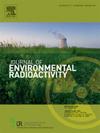Characteristics of radon transport and optimization of ventilation parameters in large-scale underground cavern
IF 1.9
3区 环境科学与生态学
Q3 ENVIRONMENTAL SCIENCES
引用次数: 0
Abstract
Radon penetrates into the underground caverns through the pores/fissures of the surrounding rock, resulting in high radon concentration area and endangering the health of construction personnel. The on-site monitoring of radon concentration in the underground powerhouse of Tuoba Hydropower Station is conducted in order to study the radon concentration level. The radon transport during the construction period of underground powerhouse under forced ventilation is established by Computational Fluid Dynamics (CFD) numerical simulation method. Furthermore, the distribution characteristics and long-term evolution law of radon concentration in underground powerhouse are revealed, and reasonable ventilation optimization measures are put forward and the results show that: (1) Blasting promotes the increase of radon concentration, while forced ventilation accelerates radon transport. (2) The airflow field along the axis is divided into a vortex distribution zone, a vortex influence zone and stable regions. (3) The radon transport includes both migration and diffusion processes based on forced ventilation. (4) The radon concentration decreases with the increase of height, while exhibits low concentration in the middle and high concentration on both sides at the same height. (5) Compared with forced ventilation, the combined ventilation can improve the ventilation efficiency and shorten the radon transport time. The research results can provide a scientific basis for the safety analysis and evaluation of deep engineering environment.
大型地下洞室氡输运特征及通风参数优化
氡通过围岩孔隙/裂隙渗入地下洞室,形成高氡浓度区域,危害施工人员健康。为研究沱坝水电站地下厂房氡浓度水平,对地下厂房氡浓度进行了现场监测。采用计算流体力学(CFD)数值模拟方法,建立了地下厂房在强制通风条件下施工期间的氡输运规律。进一步揭示了地下厂房氡浓度的分布特征及长期演化规律,提出了合理的通风优化措施,结果表明:(1)爆破促进了氡浓度的升高,而强制通风加速了氡的输运。(2)沿轴向气流场分为涡分布区、涡影响区和稳定区。(3)氡输运包括以强制通风为基础的迁移和扩散过程。(4)氡浓度随高度的增加而降低,中间浓度低,同一高度两侧浓度高。(5)与强制通风相比,联合通风可以提高通风效率,缩短氡输送时间。研究结果可为深部工程环境的安全分析与评价提供科学依据。
本文章由计算机程序翻译,如有差异,请以英文原文为准。
求助全文
约1分钟内获得全文
求助全文
来源期刊

Journal of environmental radioactivity
环境科学-环境科学
CiteScore
4.70
自引率
13.00%
发文量
209
审稿时长
73 days
期刊介绍:
The Journal of Environmental Radioactivity provides a coherent international forum for publication of original research or review papers on any aspect of the occurrence of radioactivity in natural systems.
Relevant subject areas range from applications of environmental radionuclides as mechanistic or timescale tracers of natural processes to assessments of the radioecological or radiological effects of ambient radioactivity. Papers deal with naturally occurring nuclides or with those created and released by man through nuclear weapons manufacture and testing, energy production, fuel-cycle technology, etc. Reports on radioactivity in the oceans, sediments, rivers, lakes, groundwaters, soils, atmosphere and all divisions of the biosphere are welcomed, but these should not simply be of a monitoring nature unless the data are particularly innovative.
 求助内容:
求助内容: 应助结果提醒方式:
应助结果提醒方式:


